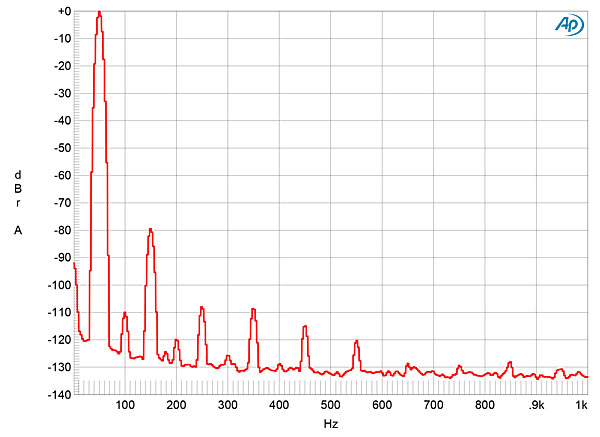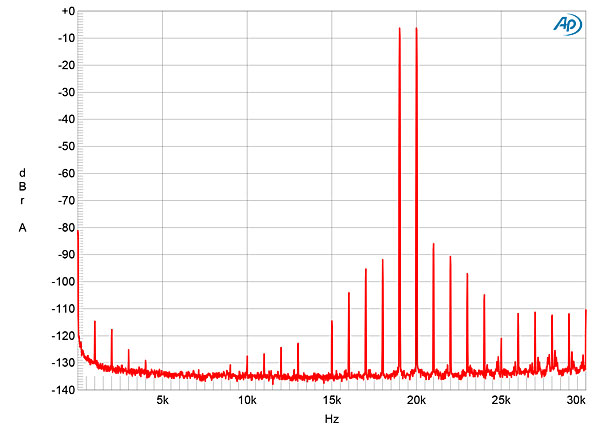This is a review and detailed measurements of the Yamaha WXA-50, multi-function DAC, pre-amp, power amp, streaming and multi-room unit. It is on kind loan from a member. Even though it came out a few years ago (2016?), it is widely available. Amazon shows it costs US $478.
Success of SONOS as a multi-room audio solution has been the envy of many traditional audio companies. Many have tried to chase them with Yamaha being one of the earlier ones.
The WXA-50 is a surprisingly heavy unit although looks somewhat unremarkable:
The case is metal as best as I can tell which is good as the unit generates good bit of heat. Strangely the heat is concentrated on the left side yet the vents are on the right!
There is an IR hole on the left which confused me to no end, constantly wanting to push it to turn on the unit.
I am not a fan of a single light indicating input and overload condition of the amplifier. Worst part of the interface is the volume control which has no marking and no display. Unless you use the app, you have no idea what volume you have set this to. This made my testing maddeningly hard.
I downloaded the App and here, I was pleasantly surprised by the performance and reliability of it. With no configuration, the WXA-50 was recognized and manipulating its controls were instantaneous and reliable. I only used the App to reset the EQ, etc. so for its full functionality, you should seek out other reviews.
The back panel has extensive set of inputs and outputs although lacks USB:
I was pleased to see both analog input and outputs.
Yamaha heavily courted the Custom Install (CI) industry to use this instead of SONOS and it shows from inclusion of trigger input and output for control. Inclusion of Toslink input goes along these lines to fetch audio from a TV being fed by HDMI.
DAC Audio Measurements
I briefly measured DAC performance. I read however that there are two DAC chips inside this unit (an ESS and Bur-brown/TI) and that the fixed output is driven by the latter. So this may not be representative of what happens when you stream music into this device:
View attachment 28716
This is decent performance although it degraded fair bit if I turned up the volume on the amplifier to max. That increased the higher order harmonics even though the output level of the DAC did not change. We have seen this before and likely is the power supply sagging causing DAC performance to suffer. SInce you don't listen at max volume level, I did not derate the WXA-50 performance when including it in the performance chart:
View attachment 28717
Amplifier Audio Measurements
Since we have analog inputs, I started my testing using that and got this for our usual dashboard at roughly 5 watts:
View attachment 28722
I played around with combination of input levels and volume control and performance was pretty consistent. SINAD (signal over noise and distortion) is actually quite respectable for an amplifier:
View attachment 28723
I tested the same, this time using Roon to stream the 1 kHz tone to it using Airplay:
View attachment 28724
We lose just a couple of dBs although distortion levels are a bit lower.
From here on, I tested the unit using its analog input unless specified.
Frequency response shows decent bandwidth and flat response in audible band:
View attachment 28725
No strange and limiting digitization of input is visible which is good.
Signal to noise ratio is good enough for 16 bit audio:
View attachment 28726
Let's get into all important measurement: power into 4 ohm versus distortion:
View attachment 28727
We are close to meeting the spec (I measure at much lower distortion than they do). We have cleaner power than either Sonos or Amazon amps although the SONOS has much more power.
Here is the performance at 8 ohm:
View attachment 28728
I don't have as much data for 8 ohm but what is there, shows competent performance but with just 55 watts on tap.
Intermodulation distortion versus power level tells a similar story:
View attachment 28729
THD+N versus frequency and power shows very predictable performance with no corner cases exposed:
View attachment 28730
Only 20 Hz tones gives it a bit of trouble with rising distortion above 10 watts but that is slight.
The unit also shut down at 20 kHz at max clipping level. I reduced the volume level a few notches and that went away even though I was still pushing the unit into hard clipping.
Spectrum of 1 kHz tone with no AES filter shows the usual noise in high frequencies we get from class-D amps:
View attachment 28731
While this looks ugly, the spikes near audio band are way down at -75 dB which is very good. I have tested amps where these levels are much, much higher.
The two channels have different switching frequencies. Not sure if this is on purpose or variation in the clock source of their modulators. The two beat against each other likely creating the intermodulation spikes that we see throughout the range.
Conclusions
Unlike the bag of parts performance I often see in these modern streaming products, the Yamaha WXA-50 seems to have benefited from some attention to raw performance of each subsystem. There are no funny results, strange pipelines that go in and out of digital domain, etc. The performance graphs are all smooth with no sudden jaggies or other anomalies. This makes it easier to use the unit, not having to work around its weakness (I am talking to you SONOS).
We also have decent amount of power, approaching 100 watts into 4 ohm which should be plenty. If you add the subwoofer to it, you will be golden even at high SPLs.
The app likewise, gives a feeling of polish that I often find lacking in competing products.
In summary, I did not raise an eyebrow when measuring the Yamaha WXA-50. It won't provide competition to state-of-the-art separate products but it also doesn't embarrass. As such, I am going to put the WXA-50 on my recommended list.
------
Questions, comments, critique, etc. are welcome.
I was reading that the standard diet for panthers is large animals such as deer, antelope, etc. I have not fed anything like that to my panthers and they are starting to mumble "animal abuse" under the lips. Before this gets out of hand, please donate money so I can purchase some real game to feed them using:
Patreon:
https://www.patreon.com/audiosciencereview), or
upgrading your membership here though Paypal (
https://audiosciencereview.com/foru...eview-and-measurements.2164/page-3#post-59054).
Stellar S300 below uses ICEpower 300AS1, which also has buffer on the board.



